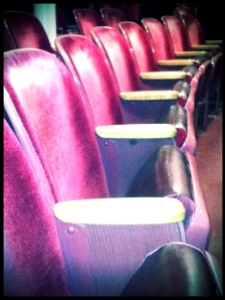From the Velveteen Chair: A Chamber Music Review
The aftermath of the events at the Boston Marathon had me wanting to shut off my thoughts and the television and get lost in something mindless. Luckily I had the perfect escape and I went to the final performance of the Pittsburgh Chamber Music Society 2012-13 Season. The Ebène Quartet was playing last night at the Carnegie Music Hall connected to the Carnegie Museum of Pittsburgh in Oakland. I love going to museums at night. It brings out a giddy, imaginative, childish quality in me. There is something that feels really sneaky about being in a museum after dark, like you may live out your childhood dream of being locked in after hours and left alone to explore a mysterious building and all the wonders it holds.
The Music Hall is beautiful and intimate with theatre style seating for 1,950. The acoustics were amazing and it was a treat to be so close to the performers and hear such fullness in the sound. Built in 1895 the hall has the feel of a warm, pleasant space. It’s covered in opulent, gilded details yet it’s sagacious size makes it approachable. This enables the hall to welcome an eclectic mix of listeners both dressed for a night out to hear sophisticated music and maybe an afternoon patron of the museum that decided to stick around for the show.
What a way to end the season for the Pittsburgh Chamber Music Society. PCMS was established in 1961 with the mission to provide Pittsburgh audiences the ability to hear some of the world’s finest chamber musicians. The PCMS seems to strive for diverse, quality performances and they didn’t disappoint. I play classical pieces on the piano but I lack a lot of knowledge when it comes to the history of classical music. This being my first chamber music concert I decided to do some research on the topic. Chamber music dates all the way back to Medieval times and is a small group of instrumentalists playing classical music. Traditionally there would be amateur musicians playing in a salon or hall in a castle or palace. This style of music moved some of our most famous composers from intimate venues among friends to concert halls for thousands.



Photo By: Brad Truxell (See his site, somethinghdr.com for more amazing photos of Pittsburgh)
The ensemble began the performance with Mozart’s Divertimento in F Major with three movements. For those of us with limited classical music knowledge a movement is a section or self-contained part within one piece. It was popular in the time period to have the movements arranged in a certain sequence (For example, slow, fast, slow) or in an order that provides some contrast but yet still flows. Viewer tip: It’s customary to hold your applause until all the movements are played: Don’t be the lone clapper!
In 1772 a young Mozart composed K 136-138 in preparation for a visit to Italy. When I was sixteen I was lucky if I could get to school on time before the first period bell rang. What’s the K for anyways? Click to learn more about Köchel, the man behind the OCD level of organization of hundreds of Mozart’s pieces. The three movements were light and airy. The Allegro begins with a certain buoyancy and follows with a tender Andante. My favorite was the final movement, the Presto, a vivacious ending and it was as entertaining to watch the expression and movements of the ensemble as it was enjoyable for the ears.
Next came Quartet in F Miner Op. 80 by Mendelssohn. This quartet has four movements and is often called “Requiem for Fanny” because Mendelssohn composed it after the death of his sister. With a more somber tone, I’d like to envision these movements connecting together playing out a life story of his sister with glimpses of life emerging throughout the piece. Finally, the performance ended with Tchaikovsky. Mainly known for his orchestras and ballets, it is apparent in his chamber composition, as the music danced through the air in the hall. The Quartet No. 1 in D Major Op. 11 is infused with Russian folk elements and made for an enjoyable finale.
The Ebène Quartet is a french group comprised of two violins, a viola and a cello. They are critically acclaimed and have a refreshing, young spin on classical music. The quartet works as a group beautifully and seamlessly together. The crowd shared my sentiment and the quartet received a standing ovation at the end of the performance and returned to the stage for an encore. I was surprisingly unaware that classical concerts had encores, but the audience was delighted to hear more. They played a rendition of the theme song from Quentin Tarantino’s Pulp Fiction. It was an example of both the appreciation and knowledge of classical works yet a whimsical take on the music as if breathing new life into a timeless sound. CD’s sold out after the show and a long line of “classical music junkies” lined up for autographs and I have to admit, I was one of them.
Visit http://www.quatuorebene.com for more information about the quartet.
Patron Tip: Parking and the bar in the event were both cash only so hit up the ATM beforehand! There was also a small pre-performance in the lobby so support local artists and arrive early!



